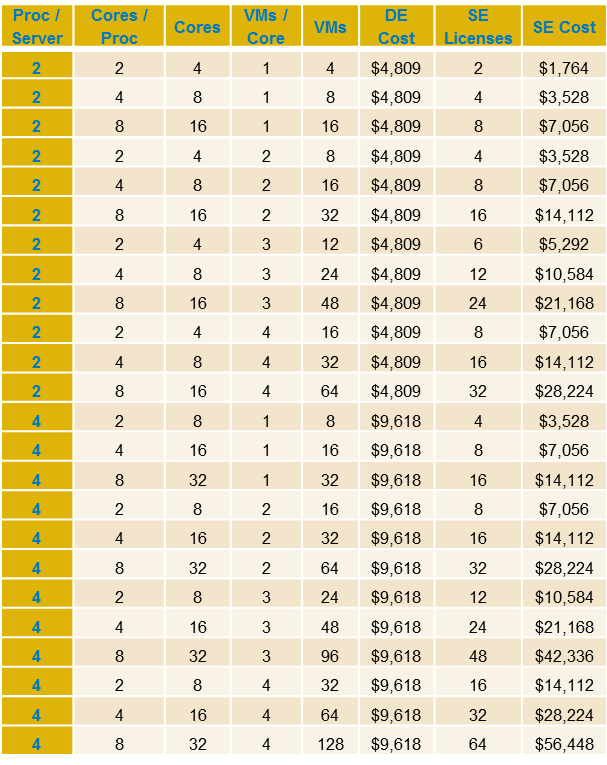Windows Server 2012, which was rolled out in September, has 4 editions, with 2 editions focused on virtualization—Standard and Datacenter. Standard is about 18.3% of the Datacenter edition cost1. A license covers 2 processors, regardless of the number of cores per processor or the clock rate of the processor. All processors in a server must be covered by licenses and no mixing of editions is allowed. The virtual machine rights are quite different for each edition, where Windows Server 2012 can only be running in 2 VMs for Standard edition, compared to an unlimited number of VMs for a Datacenter edition license. From a financial point of view, are there any conditions that would make stacked2 Standard edition licenses more attractive than Datacenter licenses?
Modern processors have multiple cores per processor and licensing often follows the number of cores, such as for Microsoft SQL Server 2012. But Windows Server 2012 is licensed per processor. The number of VMs that can be effectively run (performance wise) is limited by the number of cores. Optimization of Datacenter licenses is achieved by maximizing the number of cores and minimizing the number of processor pairs (2 at a time).
IT Asset Management
It all starts with knowing what’s in your IT ecosystem. Flexera One discovers even the most elusive assets whether on-prem, SaaS, cloud, containers and more.
As an example, the Intel E7-88xx/48xx/28xx processors support 6-10 cores depending on the model. If 1-4 VMs are assigned per core, that gives a range of 6-40 VMs per processor. If the server has 2 processors that will be covered by 1 Datacenter license, then there can be 12-80 VMs per server. The cost per VM in this scenario therefore ranges from $401 down to $60, considering a Datacenter edition license cost of $4809.1 A Standard edition license allows only 2 VMs per license, but you can stack
licenses to get more VMs. Considering the cost of a Standard edition license is $882, does it make sense to stack licenses? To cover just the low end of 12 VMs per server in my prior example, you would need 6 Standard edition licenses at a cost of $882 *6 = $5,292 that exceeds the Datacenter edition cost by 10%.
On the other hand, if you are optimizing your hardware with stacked Standard edition licenses in mind, would you come to a different conclusion? If you have more processors per server and a lower core count per processor, how does that change the outcome? Example: A server with 4 dual core processors—8 cores. It would take 2 Datacenter edition licenses to cover the 4 processors at a cost of $4809 x 2=$9,618. The number of VMs, using our 1-4 mapping is 8-32 VMs. The cost of Standard edition licenses to cover 4 processors is $882 x 2 = $1764, where each license covers 2 processors, but only 4 VMs can be running. If you need 8 or 16 VMs then stacking Standard Edition (SE) licenses costs less than Datacenter Edition (DE) as per Table 1. At 24 VMs, DE is less expensive.
This analysis shows that stacking licenses can make financial sense within very tight boundaries: (i) a 2 processor server where there are 1-2 VMs per core and a maximum of 8 VMs; and ii) a 4 processor server where there are 1-2 VMs per core and a maximum of 16 VMs.








